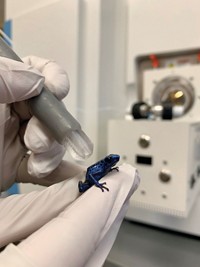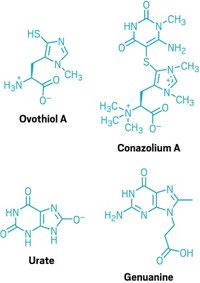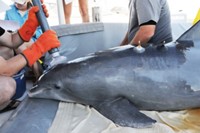Advertisement
Grab your lab coat. Let's get started
Welcome!
Welcome!
Create an account below to get 6 C&EN articles per month, receive newsletters and more - all free.
It seems this is your first time logging in online. Please enter the following information to continue.
As an ACS member you automatically get access to this site. All we need is few more details to create your reading experience.
Not you? Sign in with a different account.
Not you? Sign in with a different account.
ERROR 1
ERROR 1
ERROR 2
ERROR 2
ERROR 2
ERROR 2
ERROR 2
Password and Confirm password must match.
If you have an ACS member number, please enter it here so we can link this account to your membership. (optional)
ERROR 2
ACS values your privacy. By submitting your information, you are gaining access to C&EN and subscribing to our weekly newsletter. We use the information you provide to make your reading experience better, and we will never sell your data to third party members.
Environment
Snatching whale snot from the sky and other adventures in wildlife conservation
by Sarah Everts and Matt Davenport
February 29, 2016
| A version of this story appeared in
Volume 94, Issue 9

- Drones swarm to science
- How drones help us study our climate, forecast weather
- Drones 101: An Illustrated Introduction To Flying Data Collectors
- Drones detect threats such as chemical weapons, volcanic eruptions
- Drone-curious? Here’s how to fly science missions legally
- How drones can help keep our food supply safe
- Drones scout out locations for energy-generating wind turbines
- Snatching whale snot from the sky and other adventures in wildlife conservation
- What’s on the horizon for drones doing science?
Call him Iain Kerr. Some years ago, he met Roger S. Payne, a biologist best known for hunting whales with his ears, rather than harpoons. Prior to about 1970, nearly everything known about whales came from studying their corpses, Kerr says. His meeting with Payne, who helped discover the songs humpback whales use to communicate, left him enamored with the idea that researchers need not kill the leviathans to learn about them.
Kerr is now the chief executive officer of the conservation group founded by Payne, Ocean Alliance, and is working to push whale research to its noninvasive limits with the help of flying robots—flying robots called SnotBots that catch what amounts to whale boogers.
Within the pages of “Moby-Dick,” Herman Melville speculated that the oily mist spewed from blowholes contained intimate whale secrets. Researchers agree. The pungent spray is a treasure trove of genes, microbes, and hormones, with that last category among the most promising chemical indicators of whale health.
But existing whale-snot-collection methods are cumbersome. To catch blow from whales, researchers have wielded 9-meter carbon fiber poles with nylon tissues attached and piloted petri dishes affixed to notoriously finicky remote-controlled helicopters. Sample collection is where stable, easy-to-fly SnotBots—modified commercial multirotor drones—can help.
When a whale surfaces to breathe, a SnotBot launches from an Ocean Alliance boat to the whale, waits for the whale to exhale, catches the blow in a petri dish, and returns with the goods, Kerr says. Researchers then transfer the snot to vials, which are stored in liquid nitrogen. The team has optimized the catching of snot, but it needs to overcome some challenges before conclusive analysis begins.
Rosalind M. (Roz) Rolland, a senior scientist in marine conservation medicine at the New England Aquarium, knows all about these challenges. She’s not involved with the SnotBot project, but her team has used immunoassays to measure hormones in whale blow such as corticosterone, progesterone, and testosterone, which are tied to stress, pregnancy, and sexual maturity, respectively.
“We know we can measure all of them. It’s the quantification that’s difficult,” she says. Beyond biochemical signatures, each whale blow sample also contains an indeterminate amount of seawater, Rolland explains.
So even though the researchers can measure small amounts of the hormones, it’s difficult to determine the compounds’ concentrations inside the whale and how they correlate to the animal’s health. “Dilution is a problem,” Rolland says.
That’s perhaps the largest obstacle facing Kerr and his team, but Rolland is still excited by the prospect of SnotBots. “There’s a lot of new technology that can be brought to bear on this field,” she says. “That certainly includes drones.”
Kerr, too, is optimistic that drones could enable a new, noninvasive research paradigm—an optimism bolstered by a recent SnotBot expedition in Patagonia. “What’s really exciting is that these animals do not seem to care about the drone,” he tells C&EN. “This all started with Roger Payne saying we don’t have to kill whales to study them. Now, they probably don’t even know that we’re studying them.”
The (air)craft of conservation
Whales aren't the only animals getting help from drones





Join the conversation
Contact the reporter
Submit a Letter to the Editor for publication
Engage with us on Twitter